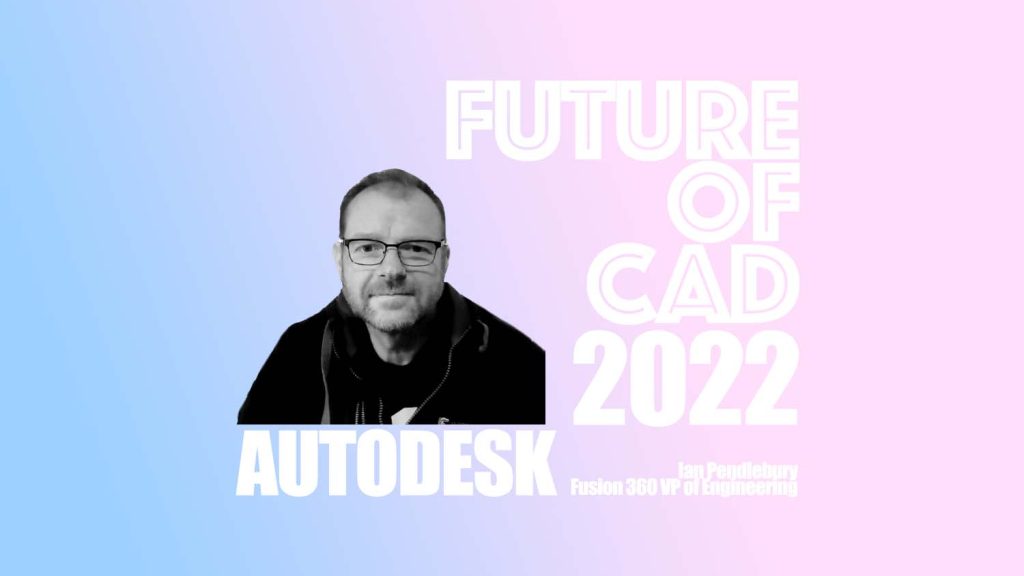 Future of CAD – Autodesk
Future of CAD – Autodesk
Time stands still for no-one – including design software, so we asked Ian Pendlebury Autodesk VP of Engineering for Fusion 360 for their opinions on the direction of CAD, ranging from initial concepting workflows, the impact of Artificial Intelligence (AI), and even how we keep it up to date
Q
How do you imagine sketch tool environments evolving?
Most 3D CAD software today assumes the user is working with a powerful desktop computer, large display, keyboard and mouse – the same basic setup for sketch that has been around for decades.
In the short term, 3D CAD will become much more adept at using the wider spectrum of input devices available today, including smaller devices, touch input, multi-touch, 3D touch, track pads and digital pens.
Moreover, the software will be aware of the device a user has chosen, and the context in which they’re working, and transition smoothly back and forth between these combinations. This will drastically improve the user experience. There are some special challenges in 3D CAD related to seeing and controlling everything in a design, especially when using a 2D touch control device for a 3D model. But we’re overcoming those challenges and creating more natural ways to interact with CAD software.
What’s really exciting is thinking longer term: As cloud-powered CAD becomes more prevalent and its AI capabilities more accessible, the need to define a design via sketches is giving way to describing the requirements and receiving design suggestions from the computer
These suggestions take a multitude of factors into consideration, such as preferred materials (and a material’s carbon footprint, or supply chain issues impacting its availability), manufacturing methods and locations, customer locations, serviceability requirements and more.
The computer is beginning to offer design suggestions that balance all the design requirements. For the first time, CAD is truly becoming computer aided. We are seeing the beginnings of this with the Generative Design and Automated Modeling capabilities in Autodesk Fusion 360, and more capabilities will continue to help users create solutions to the problems they describe to the software.
Q
How do you imagine designers will interact with CAD UIs in the future?
CAD software such as Autodesk Fusion 360 will become much better at understanding the device it’s running on and the touches, gestures or other inputs, as well as the size, that are natural to that device. It’ll be something like responsive design for the web.
In many cases there will also be native apps for specific devices (browser-based Fusion, and apps for phones and tablets, for instance). Traditional CAD layout characteristics and methods of controlling the software, such as clicking-and-dragging, will trend away from the traditional paradigms of the mouse. Instead, we’ll see new, more natural ways of interacting with the devices we’re using–like swiping with phones and grasping in VR.
Q
Downloading regular updates to a 3D CAD package is more common – is this the way all 3D CAD is now heading?
It’s important to realize that with Fusion 360, we’ve created a completely integrated product development platform that includes enterprise-grade 3D CAD, but has a vast number of other features and capabilities that go beyond the design and address the entire lifecycle of the product. A solution like this requires everyone be able to exchange pieces of the project data without being hobbled by running incompatible versions of software or exchanging large, proprietary files.
But while we see great benefits to all users being on the same cloud-powered, up-to-date, always-on version of a 3D CAD package, there are also instances where the more traditional process needs to persist, so we don’t see it going away anytime soon. Instead, we expect to continue seeing a hybrid set of offerings: most users will benefit from the many advantages of software as a service.
Those that need to control exactly when updates are implemented, or have the ability to revert back to software acting exactly as it did at some point in the past, will also be provided solutions.
Q
How do you view the increase in AI impacting design tools the most?
In the very short term, AI will get much better at quickly, naturally making design suggestions to a CAD user that are close to what that person would otherwise create on their own. One example we are working on will automate the time-consuming process of creating a 2D drawing from a 3D CAD model.
Machine learning will look at how a designer typically dimensions similar parts and automatically create a drawing that is very close to what that designer would likely draw. Another example is the Automated Modeling feature recently released in Fusion 360, which does not require a user to change environment, tool or context in order to use the AI capabilities in the software. Instead, like a real-time spell-checker, it looks at what you’re designing and suggests efficient connections between faces or bodies.
Cloud AI is being seamlessly integrated into design tools and workflows, increasing the speed and value of those tools by automating the time-consuming, but not highly creative, work that every project inevitably has.
As software continues to evolve by incorporating learning capabilities, it can start to make suggestions and even decisions on the user’s behalf, based on previous behaviours and choices, helping to reduce errors and reach better outcomes faster.
Q
How do you imagine the users of your software will change and how do you see this impacting the software?
CAD users of all ages are growing more accustomed to moving back and forth between desktop applications, mobile devices and apps, and browser-based experiences, and expect a smart hand-off from one to the other.
This trend was partially accelerated by the pandemic, during which most people needed to remain productive even when working from home on older laptops (or students on Chromebooks). This led to more widespread understanding of the benefits of cloud-first CAD like Fusion 360, which uses the power of the cloud to execute complex CAD modelling, even on less-powerful computers or when accessed through a browser.
On the other end of the spectrum, we see rapidly increasing performance and capability offered in the latest high-end phones and tablets, blurring the lines between desktop and mobile. Users investing in expensive computing devices expect their apps to utilise the capabilities of those devices, so we’ll see dedicated, native CAD apps that sensibly take advantage of features such as touch, multi-screen and powerful GPUs, CPUs, and NPUs.
In short, we’ll see CAD software become more user aware, device aware and adaptive. Designers and engineers will more naturally and intuitively contribute to a project regardless of whether they’re working from a browser, a mobile device or a traditional workstation in the office.
Q
When will CAD software be able to take advantage of modern graphics APIs for better 3D performance and advanced features like GPU ray tracing?
The movie and video game industries have pioneered some amazing performance enhancement technologies that we believe will bring great benefits to rendering the most complex CAD models. We are actively working on adopting USD (Universal Scene Description) and the USD Hydra rendering framework, which are fast becoming industry standards, into Fusion 360.
USD is all about incredible performance through heavy use of multi-threading and GPUs. It takes advantage of modern graphics APIs and offers cross-platform support.






